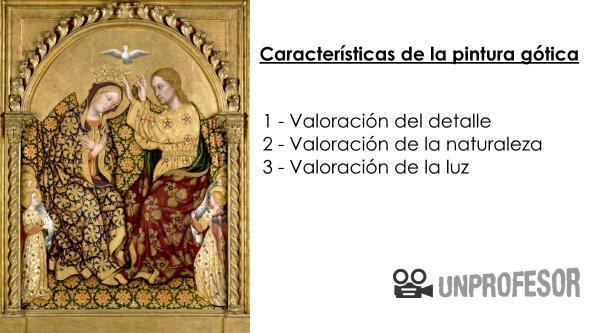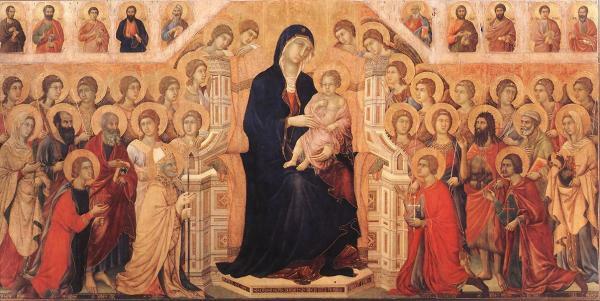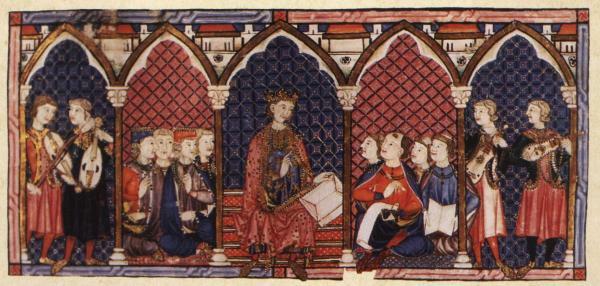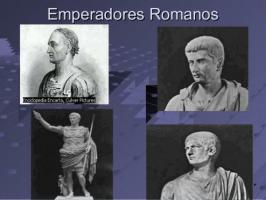Gothic painting: General characteristics

The Gothic is not the continuation of the Romanesque, but a time of great civil, economic, religious and artistic transformations that is the subject that concerns us. This historical-artistic period encompasses from the middle of the 12th century to the beginning of the 16th century, although each country will present a different evolution. Next, in this lesson from a TEACHER, we will see what are the general characteristics of gothic painting that distinguish it from the rest.
Index
- Introduction to Gothic painting
- Most prominent features of Gothic art
- Spain and Gothic art
- Gothic painting in France
- Gothic painting in Italy
Introduction to Gothic painting.
We start with the general characteristics of gothic painting speaking, first, of the places of application of said paint. By replacing the walls with large windows in the Gothic style, mural painting will be reduced, except in Italy. In this period you will charge a stained glass windows, miniatures, and panel painting are more prominent.
The most frequent topics are going to be religious, inspired by the life of Jesus and the Virgin, as well as that of the saints, among which the titular saints and the apostles stand out. Also, although to a lesser extent we will find profane painting with the appearance of portraits and landscapes. With regard to the techniques the most used are going to be fresco, egg tempera and oil.
In this other lesson from a TEACHER we will discover the general characteristics of Romanesque art.
Most outstanding characteristics of Gothic art.
The most important characteristics of gothic painting They are:
- Assessment of detail, that is, it will be a very descriptive painting.
- Appreciation of nature, identifying God with it.
- Valuation of light, proliferating stained glass and painting with golden backgrounds.
With regard to evolution, this period is divided into three phases:
1st Phase: XIII century; is the call linear gothic or frank - gothic (due to its appearance in the first French cathedrals) and its main characteristic is going to be the drawing line.
2nd Phase: XIV century; is known as italo - gothic or trecento. His greatest concern will be centered on depth, on a closer approach to the representation of reality and on anatomy, the two most important focuses being Siena and Florence.
3rd Phase: XV century; is known as international style or international gothic, its most dominant note being realism. A certain similarity with flamenco art is also revealed. It features bright colors, sleek and smooth shapes, and curves, arabesques and wavy rhythms take on importance for greater expressiveness. This style owes a lot to the miniature.

Spain and Gothic art.
We are now going to analyze the general characteristics of gothic painting but focused on Spain. It is the second country in pictorial importance after Italy, the difference is that here the mural painting is going to recede before the altarpiece. This period is divided into four stages:
1st Stage: Linear Gothic (13th century)
In this phase we are going to have cut out, linear figures, still very close to the Romanesque. The most important example is the front of Aviá.
2nd Stage: Italo - Gothic (XIV century)
Figures tend to be more volumetric. The most prominent example is in Catalonia with the Serra brothers and his altarpiece of the Holy Spirit from the Cathedral of Manresa.
3rd Stage: International Gothic (XV century)
In this phase the pictorial is going to predominate over the linear, for this we are going to focus on two focuses: Castile and Catalonia.
- Catalonia; here due to the multiple commercial relationships of him, the influence of Italian painting is received. As artists highlight Martorell whose most important work is Saint George.
- Castile; here the Italian influence is later and is a Gallic author, Nicolas French, the one that introduces the taste for the decorative and refined. He owes the altarpiece of the Virgin of the Prado Museum.
4th Stage: Hispanoflamenca (late 15th century)
A great influence from Flanders appears as a result of the intense relations between Castile and Catalonia. Oil began to be used, giving tactile values to painting; the perspective is already achieved with enough precision, the three-dimensionality and the depth effects.
We are going to focus on three focuses: Catalonia, Andalusia and Castilla.
- Catalonia: where we have Dalmau with his work the Virgen dels Concellers.
- Andalusia: highlights the work of Bartolomé Bermejo, where he will combine the dramatic and spiritual, as can be seen in the Portrait of Santo Domingos de Silos.
- Castile: where we have Fernando Gallego, which is characterized by the fact that in his characters he uses a series of metallic folds and clothes like starches, together with a very elongated canon of the figures. His most important work is the Piety.

Gothic painting in France.
In this country painting is presented with a certain tendency towards naturalism and expressiveness. In the fourteenth century a mobile easel painting began to be made, and in the fifteenth century we have important works miniature books, which are luxuriously decorated books that were used for personal use, we highlight the Duke of Berry's Books of Hours which are devotional books for prayer and are illustrated by the Limbourg brothers.
Also cite the Avignon School, that among his most significant works is the Pieta of Avignon, where very monumental figures appear with a marked drama.
Gothic painting in Italy.
Italy will mark a fundamental note in the painting of this era by searching for a scale of proportions to convey a notion of three-dimensionality. The painting is not going to be linear nor is it going to be located in one area, but rather it is going to have different areas. In general, the characteristics of this country will be:
- The survival of the late Roman tradition.
- Byzantine influence.
- Prevalence of fresco mural painting.
As we said previously, in the thirteenth we are going to find two foci: Siena and Florence.
Florence
We have to stop at a great teacher who is Giotto. This painter has been said to be the initiator of modern painting, since he anticipated the figures of the Renaissance. He will make a study of the man, giving the characters a great monumentality with an almost sculptural volumetric sensation. The formal characteristics are as follows:
- The monumentality of the characters (which has been seen as the precedent of Michelangelo's gigantism).
- The eyes are going to be almond-shaped and elongated.
- Introduction of landscape in paintings, with which he put an end to flat or neutral backgrounds.
- Sense of depth, managing to represent the figures in profile or from the back, that is, the human body is discovered in its volume and relationship with space.
- The figures will present a certain sentimentality, in which their ability to love and suffer is detected.
His most important work done in fresco is the Resurrection of Lazarus in the chapel of the Arna de Padua.
Siena
It is characterized by having a painting of marked Byzantine influence, very meticulous, detailed and decorative.
Among the most important painters is Simone Martini, which is a great innovator in landscapes and backgrounds, although he continues to use gold. One of the characteristics of him is that he makes his characters with very small and oval faces, which is evident in his most important works, which is Annunciation. He also made paintings of a social nature such as the equestrian portrait of Guidurico da Flogiano, revealing an urban landscape in the background.
If you want to read more articles similar to Gothic painting: General characteristics, we recommend that you enter our category of Story.



